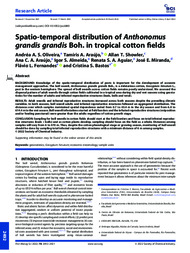Spatio-temporal distribution of Anthonomus grandis grandis Boh. in tropical cotton fields.
Spatio-temporal distribution of Anthonomus grandis grandis Boh. in tropical cotton fields.
Author(s): OLIVEIRA, A. A. S.; ARAÚJO, T. A.; SHOWLER, A. T.; ARAÚJO, A. C. A.; ALMEIDA, I. S.; AGUIAR, R. S. A.; MIRANDA, J. E.; FERNANDES, F. L.; BASTOS, C. S.
Summary: The boll weevil, Anthonomus grandis grandis Boheman (Coleoptera: Curculionidae), is considered to be the most harmful cotton, Gossypium hirsutum L., pest throughout subtropical, and tropical regions of the western hemisphere.1,2 Boll weevil damages cotton by feeding upon and laying eggs inside its reproductive structures, where hatched larvae feed and pupate,3,4 causing abscission or reduction of fiber quality,3,5,6 and economic losses of up to US$74 million per year.7 Boll weevil chemical control interventions are based on economic thresholds obtained by sampling the plants and for adult boll weevils captured in pheromone-baited traps.3,8,9 In order to develop an accurate monitoring and management program, estimates of population density are essential.10,11 Biotic and abiotic factors affect dynamics and within-field distribution (aggregated, random or uniform patterns) of insect populations.10,12 Knowing a pest's distribution within a field can help to: (1) develop site-specific sampling and control efforts; (2) predict pest movement; (3) improve insecticide-resistance management; (4) conserve biological control agents by precision targeting sprays for the infested areas; and (5) reduce the economic, social and environmental costs associated with pest control.10,11,13 The spatial distribution of boll weevils has been investigated using mean?variance relationships4,14 without considering within-field spatial density distribution, or has been based on pheromone-baited trap captures.15 The most accurate approach is the use of geostatistics because the position of the samples in space is accounted for.16 Recent work reported that geostatistics is of particular interest for pest management because it allows inferences about the minimum inter-sample distance needed to obtain independent estimations and indicates patterns of distribution and colonization of an organism, all of which are crucial for the development of effective sampling programs.11,13 The purpose of this study was to investigate the spatial dynamics of A. grandis grandis on cotton by determining within-field distribution of adults and infested reproductive structures (having feeding and/or oviposition punctures).
Publication year: 2022
Types of publication: Journal article
Unit: Embrapa Cotton
Keywords: Algodão, Alho, Anthonomus Grandis, Anthonomus grandis grandis, Batata Doce, Bicudo, Broccoli, Brócolis, Cabbage, Carrots, Cassava, Cenoura, Clima Tropical, Cotton, Couve, Entomologia, Entomology, Estatística Agrícola, Garlic, Geostatistics, Girassol, Gossypium Hirsutum, Hortaliças, Mandioca, Peste, Plant pests, Praga de Planta, Repolho, Sunflower, Sunflower seed products, Sunflower seed protein, Sweet potato, Tomate, Tomato, Tropical agriculture, Vegetables
Observation
Some of Embrapa's publications are published as ePub files. To read them, use or download one of the following free software options to your computer or mobile device. Android: Google Play Books; IOS: iBooks; Windows and Linux: Calibre.
Access other publications
Access the Agricultural Research Database (BDPA) to consult Embrapa's full library collection and records.
Visit Embrapa Bookstore to purchase books and other publications sold by Embrapa.

